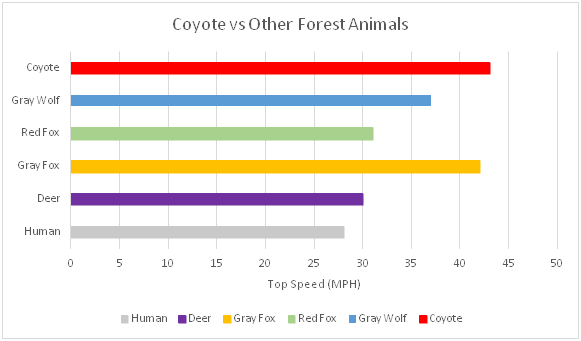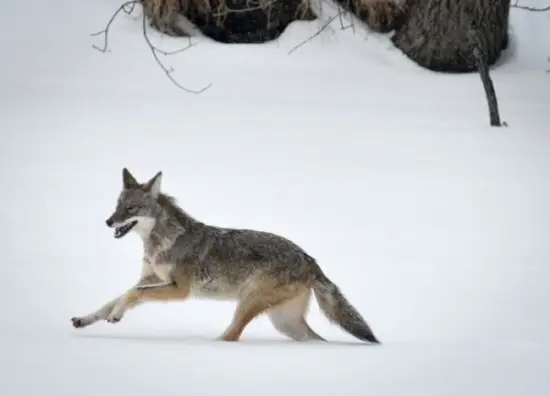Stealthy Until Proven Speedy
It is common knowledge that coyotes are stealthy animals that can creep around the forest without being detected by the human senses. They often take slow, controlled steps and survey their environment as they travel. But, what if they are in a hurry? How fast can they run? How fast must another animal be to escape a coyote that is pursuing it? How far can their momentum propel them through the air? What if Wile E. spots the Road Runner and is out of TNT? Can he catch him?
Per the Speed of Animals website, coyotes can run up to 43 miles per hour (69 kilometers per hour). So, in real life, Wile E. should have no problem at all catching Road Runner whose top speed is only 20 miles per hour. But, thankfully for our blue feathered, beeping friend he is a cartoon.
Who Wants to Race?
Unfortunately for the whitetail deer who cohabitate the forest with these coyotes, 43 miles per hour is faster than the average deer whose top speed is only 30 miles per hour. While hunting in packs, these speedy predators can quickly exhaust and overtake a deer to feast upon. Most other forest animals and livestock are in a similar situation as the deer, and very few animals that a coyote is likely to encounter could match or surpass its speed.
The grey fox, moose, and jackrabbit would all easily give the coyote a run for his money in a head to head race. And, maybe they do. Maybe this is one activity of magical forest animals that Disney forgot to mention to us as kids.
Sprints or a Marathon?
While some could keep up with the coyote in sprints, few animals could match his endurance. Not only can these animals move quickly, they can also move continuously. Whether alone or moving with the pack, these canines are always planning or making their next move. The State University of New York’s College of Environmental Science and Forestry states that in one day a coyote may travel between 3-10 miles (5-16 kilometers). Be it for hunting, den making, mating, or just sight-seeing, these critters travel often. Being a homebody just is not part of their DNA.
Running for Life
Coyote pups are much more susceptible to predators than their parents. The sooner they can move their tiny paws in the direction of safety, the better their chances are for survival. While the adult coyotes try to protect them, larger animals like bears or cougars are more than one or two coyotes can handle.
As they age, coyotes who live near humans tend to cross roadways frequently. These crossings often kill coyotes unless they are quick enough to make it across.
Tread Lightly
Whether walking, trotting, or running, coyotes are resourceful in their routes and often use logging roads, deer paths, and hunting trails to travel by. Using these paths offers them quieter travel with increased visibility that allows them to maintain a low profile while monitoring their surroundings. For further noise reduction, coyotes will even walk on their toes to avoid crushing leaves and twigs underfoot.
Talk to the Tail
When coyotes are spotted by humans, they are often running quickly across open fields or clear cuts with their tail down. This tail position differs from the coyote’s cousins who either run with their tails in the air like domestic dogs or straight out like wolves. This position is aerodynamic and convenient when hunting. By keeping its tail down while running and into the pounce of its hunt, it keeps it away from other coyotes’ and its prey’s mouths.
Coyote Triathlon: Running, Jumping, and Swimming
What else can coyotes do? Speed of Animals cites our ferocious furry friends leaping over long distances of up to 13.13 feet or 4 meters! Propelled by the momentum of the coyote’s great speed, these leaps help them to cover ground more quickly and overtake their prey with ease.
What about swimming? Deer and livestock can swim and will often use water to attempt to confuse their predators by scrambling their scent trails. Can coyotes keep pace? National Geographic says they are “very good swimmers.” UNY reports coyotes swimming up to half a mile (0.8 kilometer). Therefore, these canines can keep pace with their prey on land and in water, and when they get close enough, they can pounce and overtake them.
Speed, Stealth, Symbolism
Many native tribes of the Americas regard the coyote as a force of change, wonder, and unpredictability. The coyote is seen as wise but also as possessing a sense of humor in its wisdom that piques the curiosity of man. In totem, coyotes symbolize the magic in life and creation, resourcefulness, and the desire and ability to survive. These characteristics are reflected in the travel patterns of the coyote and its ability to switch gears quickly from first to fifth and then leap into the water and start swimming. This adaptability and willingness to change are desired traits among humans and elevate coyotes in folklore and native traditions.
Better Call Barney
So, how fast can a coyote run? Fast enough to get a speeding ticket in a school zone. Fast enough to overtake a deer or rabbit. And, fast enough to propel itself into a leap that covers up to 13 feet of ground. Speed balanced with stealth- two traits that make this animal both interesting and frustrating to so many hunters.
Whether with stealthy precision or adept swiftness, coyotes live their lives on the move. Sometimes covering over ten miles in a day, these furry adventurers are far from homebodies. Scoping out their hunting grounds, taking down prey, preparing new dens, and chasing mates are all just parts of the coyote lifestyle that require travel both fast and slow.
And, who knows? Maybe they are having head to head races with other critters out there and we just haven’t caught one on our trail cameras yet.

